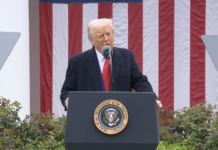
(GA Recorder) | WASHINGTON — With demand for COVID-19 vaccines dropping in many states, the federal government is changing how those doses are allocated.
Under the new policy, any doses that a state doesn’t request from its weekly, population-based allotment will be held in a general pool, and states with higher demand can request additional shots from that surplus.
President Joe Biden’s COVID-19 advisers outlined the new policy to governors during a call Tuesday morning. Senior administration officials also described the policy to reporters during a separate conference call ahead of Biden’s remarks later in the day on the nation’s vaccination push.
Under the new approach for states, they will continue to make weekly decisions on how many doses to request from the federal government. If a state orders fewer doses one week, that decision will not reduce its future allotments, administration officials said during the briefing call.
The change in how vaccines are distributed comes as vaccine appointments are readily available in most areas, and many Americans most eager to receive a shot have already done so. Many states are seeing a decrease in the number of shots they’re administering each week, according to tracking data from the CDC.
At least 56% of American adults have received at least one dose of one of the three authorized COVID-19 vaccines, according to the CDC. Nearly 105 million Americans are fully vaccinated, or about 41% of those over 18. About one-quarter of Georgians are now fully vaccinated.
During his remarks Tuesday, Biden will set a new goal, calling for 70% of U.S. adults to receive at least one shot by July Fourth and for 160 million Americans to get both shots by that date. Reaching that goal would require roughly 100 million additional shots during the next two months, according to his administration.
Getting those shots in arms will depend on finding those who are hesitant or skeptical of receiving a vaccine, making it even easier to get a vaccine, and building confidence in the newly available shots.
States will see a new infusion of money for vaccine outreach efforts, with nearly $250 million for media campaigns and targeted messaging to specific communities.
The president is expected to direct pharmacies in the federal vaccine program to offer walk-in appointments and encourage states to also offer vaccinations without an appointment. The federal government also will launch smaller, pop-up, and mobile vaccine sites, as opposed to the mass-vax locations of the early rollout.
The administration also will increase focus on outreach in rural areas, with more money and shots going directly to rural clinics and hospitals. More than $100 million from the last COVID-19 stimulus package will go to outreach and education efforts across 4,600 rural health clinics.
Another $860 million from that legislation will pay for expanded COVID-19 testing and mitigation through rural hospitals and clinics.
A Kaiser Family Foundation study released last month found a larger share of rural residents reported they had received at least one dose of a COVID-19 vaccine than those in denser cities or suburban areas, where appointments have been harder to secure. But that report also found a greater share of rural residents are waiting to get the vaccine or do not intend to get one than those in urban or suburban communities.
Biden also will call on states to be prepared to expand access to younger Americans, with an application from Pfizer expected to be approved as soon as next week that would allow that shot to be given to adolescents between the ages of 12 and 15.
His administration will be seeking to send vaccines directly to pediatricians and family doctors to boost access and uptake in that age group.







